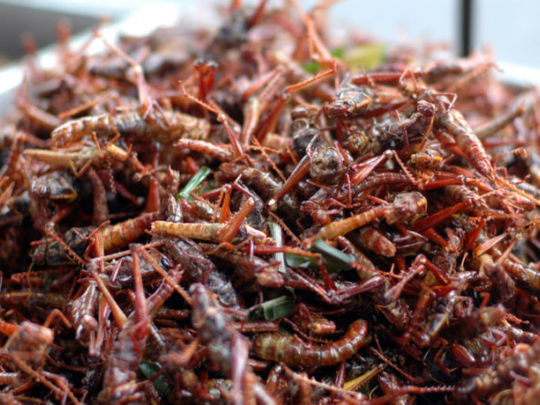
Is it time to get over our squeamishness and learn to savour the taste of bugs? On a menu fried grasshoppers, the Mexican delicacy, is described as “chapulines fundido”. Having eaten it — indeed polished it off — I would say it is the equivalent of an “insect moussaka”.
The bottom layer is made of pureed fried grasshoppers (chapulines), which have been flavoured with softened shallots, garlic, smoky chipotle chillies and lime juice, topped with a gooey, fondue-style blanket of mozzarella and cheddar cheese (queso fundido).
You can scoop it up, street-style, with corn tortillas or get stuck in with a knife and fork. And so that you are under no illusion whatsoever about the main ingredient, the dish is garnished with three crispy grasshopper bodies — minus legs and wings. Yum — or not.
Wahaca, the sustainable Mexican street-food restaurant chain co-founded by MasterChef winner Thomasina Miers in London, claims the unusual move of having it on the menu — some might say shameless PR stunt — reflects its ethos of providing interesting, flavoursome fare while encouraging people to take the next step in sustainable eating by swapping meat for a protein-rich, environmentally friendly alternative.
Meanwhile in a documentary on BBC4, Stefan Gates asks if eating bugs — from tarantulas to grasshoppers — can “save the world”.
More than 1,000 insect species are eaten in 80 per cent of countries — mostly in the tropics. The UN’s Food and Agriculture Organisation says insects are vital to meeting the nutritional needs of the world’s growing population but they hardly feature in the diets of many rich nations.
As an ingredient, chapulines are a healthy alternative to meat; cooked grasshopper contains up to 60 per cent protein, with 6 per cent fat. Miers herself believes eating insects is no different from eating shrimp or prawns; after all, like insects, they are arthropods.
“It’s just not in our psyche at the moment,” she says. “The chapulines fundido is a great introduction to the beautiful earthy flavour of these insects as it tastes amazing and a salsa is much more palatable for the more squeamish diners out there.”
You can’t argue with the need to get us to eat more sustainably, but what do the punters think? On a chilly Monday evening — the first full day of the experiment — a handful of early evening diners at the South Bank restaurant have ordered the dish.
Friends Kate Franklin and Bella Lawrence have eaten more than half the portion they are sharing. “It was very tasty, very lemony in flavour,” says Franklin, a 22-year old photographer. But Bella, also 22, isn’t sure about “the three smily faces” on top, which lie uneaten. The pair agree that the initiative was a commendable one. “After the horsemeat scandal people are definitely looking for alternatives to meat,” says Dean Huges, general manager of the restaurant.
In fact there seems to be more criticism of the heavy cheese layer — which tends to congeal as it gets cold — than the insect content. Personally, I enjoy the rich, smoky flavour and texture of the dish.
But even I am unable to wolf down an entire bowl of crunchy grasshopper bodies, which are typically served in Mexico as bar snacks. And there is also the issue of the insects’ carbon footprint. Those used by Wahaca — vaccuum-packed in large bags — are imported to the UK from Oaxaca in Mexico.
Guardian News and Media Limited











